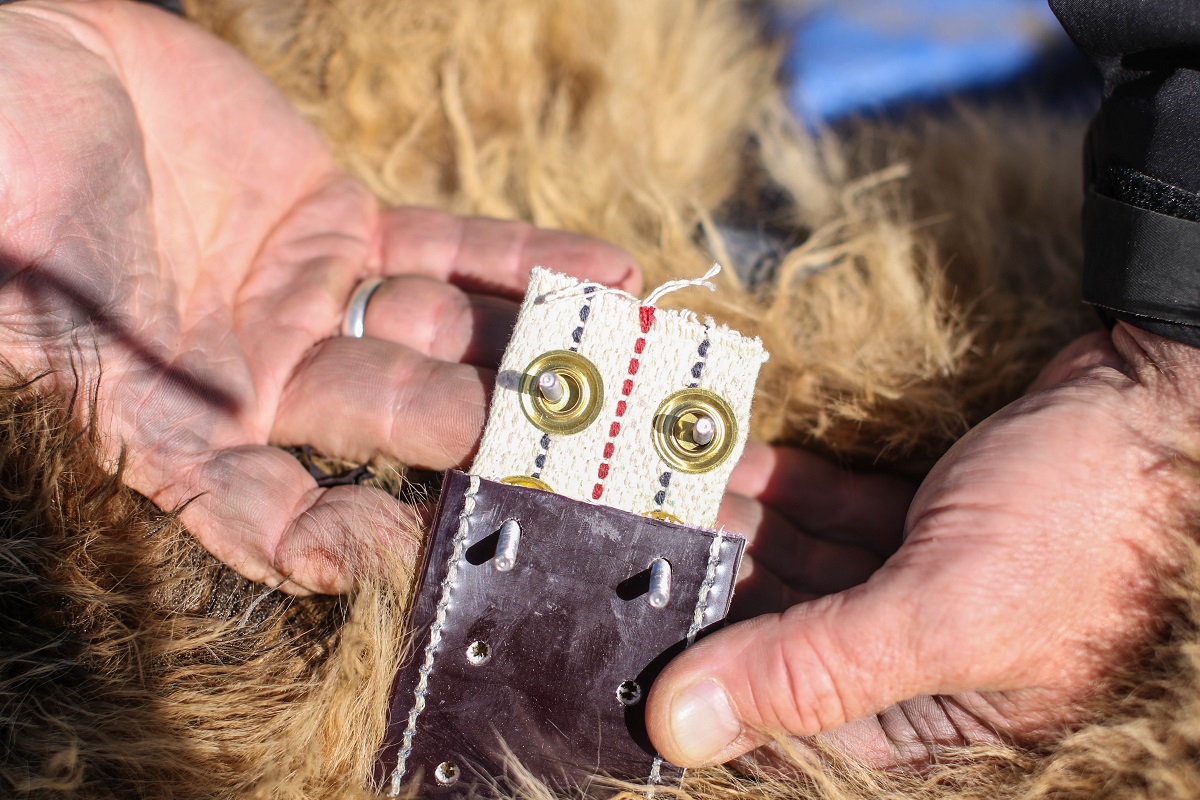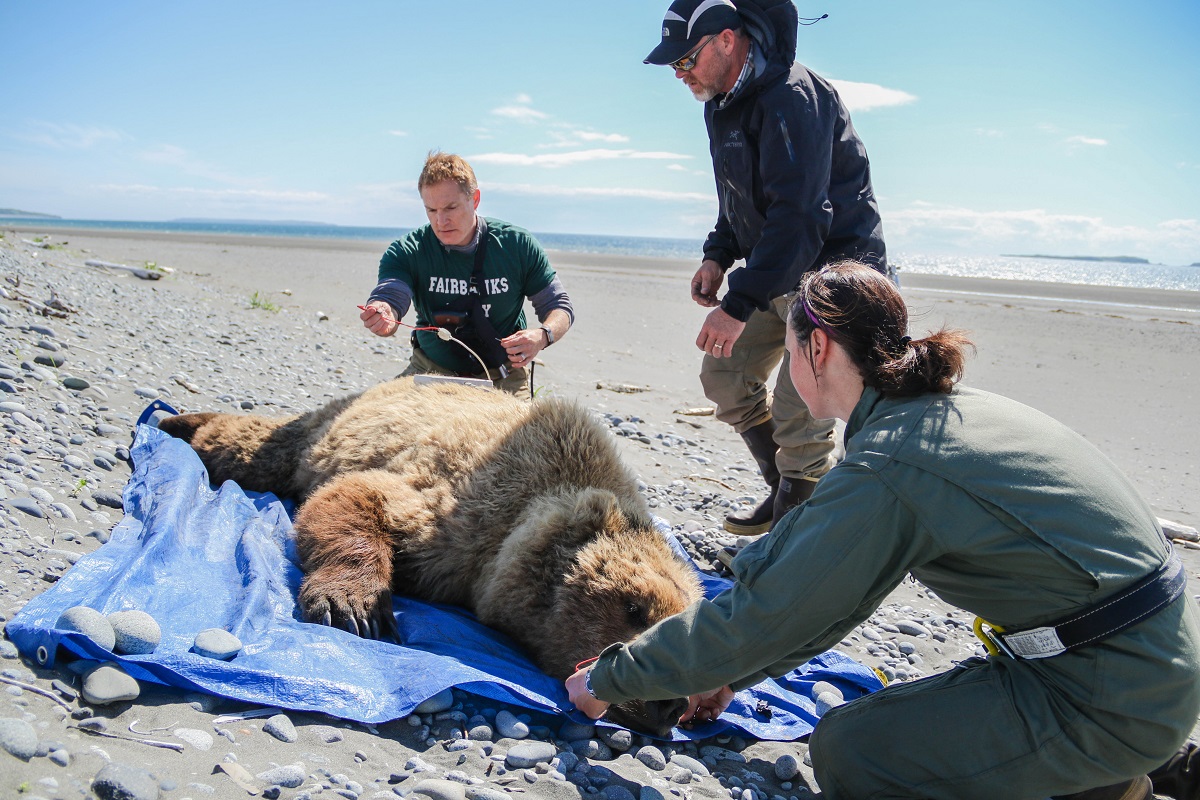They’re good stories, and they possibly have real-world analogues in some corners. At the same time, I must admit that I have never met a mad scientist. I have, however, met many researchers of a different mold. I have interacted with scientists who are genuinely caring and careful in their work. I’ve met archeologists preserving sites for both future researchers and future members of the local community. I’ve met biologists who treat the animals they study with something that can be easily described as love. I have met a number of researchers who are profoundly, refreshingly kind.
Perhaps no experience illustrates the scientist as nurturer more vividly than the bear capture work on the coast. As a science communicator, I was able to interact with researchers of the Changing Tides Project, which is studying the links between brown bears and coastal resources, such as clams and mussels. A part of this process lay in studying bear health and diets through a number of methods: through field observation, resource nutritional analysis, remote cameras, GPS collars, and more. Each part of this complex study has precedence elsewhere, but it is noteworthy for its complexity, for its integration of many methods of research. Perhaps no element of the process garners more discussion, often passionate and concerned, than the process of collaring bears and studying their condition while they are tranquilized. It can seem like a dramatic action, and those who care about these bears justifiably want to make sure they are handled well.

NPS Photo/M. Bradburn: Researchers weigh a bear from an earlier recapture. Bears gain a significant amount of weight in the summer season, recovering from the leaner months of early spring.
Having seen the process firsthand, my respect for the researchers and research has only grown. I was able be near one bear that the scientists had selected for collaring. I flew to them in a helicopter, the best method for locating coastal bears and safely landing by them (and an absolute joy to fly in, I might add). When we touched down the scientists were already fast at work. United States Geological Survey (USGS) biologist Grant Hildebrand and Washington State University graduate student Joy Erlenbach were gathering materials, and our helicopter pilot, Troy Cambier, joined in. The bear lay on a tarp on the beach. She was gorgeous: a mass of muscle and tawny fur. Her two yearling cubs, watched at a distance while the team worked. She was breathing gently as the researchers worked to collect their data.
The researchers gathered blood and fur first, shaving a small patch and expertly drawing samples. They measured body fat using an electrical charge, which showed she was at 12% body fat. Next they weighed her, hoisting her carefully on a winch, balancing her head while she rose off the ground. She weighed 410 pounds, a healthy weight for a mother bear of her size in midsummer. They studied the wear on her teeth to determine her age. She was estimated to be about 16 years old: a mother of past generations. Next came the collar. The GPS collar is relatively small but spacious enough to ensure it does not add unnecessary encumbrance, with a remote activated mechanism to detach in the event that she cannot be reached again in October. The biologists also installed canvas straps designed to wear away over time as a third failsafe. They showed me the amount of room between the bear’s neck and the collar, showing plenty of space. Finally, Grant stamped the interior of her lip with a small green tattoo, to aid in future identification.

NPS Photo/M. Bradburn: Researchers install a canvas spacer on the GPS collars, allowing the collar to wear away and break off in the unlikely event that it is not removed during the fall exams or remotely detached.
At the end of this exam, which probably took twenty minutes, they moved the bear off the tarp and set her down carefully on the sands. They turned her to face away from the sun, so that it would not be in her eyes as she woke up. They placed her on her belly so that her young cubs would not nurse when she could not push them away if they got too rough.
In speaking to Grant, Joy, and Troy, it is clear that each member of the team is experienced, as well as keen to show care in each part of the process. They talked about the tranquilizer used. It is a veterinary drug known as Telazol. It is both a painkiller and a dissociative anesthetic, which means that the bear does not remember any part of the capture process. It takes 3-10 minutes to take effect. Bears are not darted if there are any hazards nearby. I later see a video of the helicopter approaching one of the bears tranquilized. The procedure happens incredibly fast, with the bear only moving when the helicopter is close enough for a shot. And the bear stops running as the helicopter flies away seconds later.

NPS Photo/M. Bradburn: Researchers prepare to read the body fat percentage of a bear using a soft electric signal.
The biologists leave before the bear wakes up, to make the experience less stressful for her. Coastal tech Isaac later sees a mother with two cubs moving around near the lagoon, and notes that she may very well be our bear. Researchers will check up on her again in October. They will weigh her and collect new samples to determine how her diet and health has changed over the season. They will process hair and blood in fascinating ways, isolating isotopes to detect the unique carbon and nitrogen signatures of each part of her diet. They will record where she has travelled, the GPS collar having provided daily notes of her location. All of this is in service of understanding how bears use coastal environments. This information provides the knowledge park managers need in order to know how to best protect the habitat of these wild creatures in the face of changing climate and other environmental stressors.
What stands out to me the most about this project is that every person involved is committed to protecting these animals. Each decision made has been carefully weighed, every process has been considered from multiple angles. The scientists here are nurturers, handling each bear with a combination of strength and care. When they describe bears in the field, it is not just with scientific rigor. It is also with a healthy amount of respect, and even tenderness. None of them wishes to disturb these remarkable creatures, but they carry out their work in the knowledge that understanding bear health and diet will be crucial for their protection in the future. Each measurement taken, each sample drawn, has a purpose. Each part of the process is written up with a careful justification.
And I will admit that I readily see why researchers work so hard to protect these animals. As I sat next to a massive bear, watching her frame rise and fall, listening to her breathe softly, admiring the strength obvious in her arms, the graceful arcs of her face, I wondered about her life. I wondered how many cubs she had successfully raised, and how many she had lost. I wondered how she used those claws and teeth to find a wealth of food on that bountiful coast. I wondered how that thick coat of fur and those layers of fat protected her in the midst of a harsh Alaska winter. I wanted to know more about her life and the lives of her peers. I understood that some of that wondering is the first step of the scientific process. Each of the researchers I meet begins with some of that same wonder. Then they work to transform that wonder into action, and use that action to build understanding. I hope that others will take time to wonder as well.
